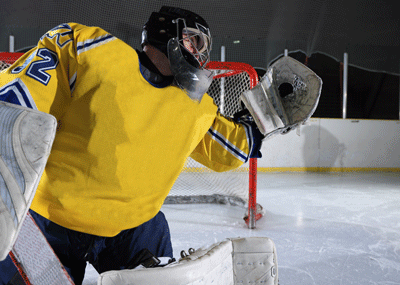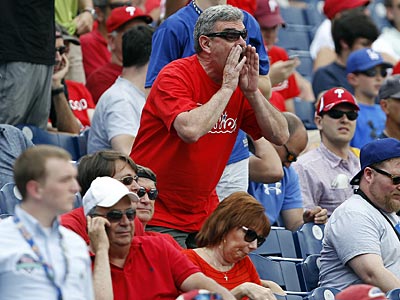Goalie Psychology – Confidence, Concentration and Focus

Mental Toughness In Sports
January 29, 2018
Composure For Pitchers
February 11, 2018Goalie Psychology – Confidence, Concentration and Focus
Confidence, concentration and focus for hockey goalies? I thought all you needed for an optimal performance as a goalie was great hand-eye coordination, a sense of positioning in the net, and phenomenal reflexes.
Guess not. Not enough.
It would appear as if nerves of steel and a mind like a steel trap have to be packed into your equipment bag as well.
Why?
The answer lies in three words, “Time to think.”
That’s the bottom line but, let’s go to the “why” thing for a minute.
Physically, hockey goaltending is a position that DOES demand incredible hand-eye coordination, positioning, and phenomenal reflexes.
I mean after all the darn thing is coming at you at speeds anywhere from 70 – 100 mph (fastest recorded time was 110 mph).
Forget STOPPING the puck. Heck, what about getting HURT for crying out loud. Personally I would want to run the other way. In fact I would be SCREAMING to run the other way.
Hard to imagine but goalies didn’t even wear masks until 1959. Take a moment to think about the anxiety levels of that alone.
How the heck did they NOT get killed? It is equivalant to a baseball player; a HITTER standing ON the middle of home plate and turned directly to FACE OFF full body frontal position against Aroldis Chapman and challenging Chapman to throw his 100 mph fastball at him.
“C’mon Aroldis. Hit me.”
Without a batting helmet.
Holy mackerel. Again, I repeat for the sake of clarity. I’m running the other way.
Secondarily, since hockey is a relatively low-scoring offensive game; the game itself could literally be riding on a single save.
However, even with those two factors, I still believe that the major issue is the “time to think” deal.
So there you are, you are following the action on the other end of the ice. Your team takes a shot on goal and the puck is passed on out to your end and HERE THEY COME!!!
Sports psychology shows your level of arousal goes from zero to full on instantly. It might seem like being attacked by squadron of kamikaze war planes hurtling toward you; dive bombing and flying in your direction at a thousand miles an hour.
Okay, this is actually the easy part because this is where your adrenaline and all the well-trained REACTIONS snap into place. Your eyes follow the puck. Here it comes. You anticipate speed and get into position and then you …
… REACT!!! … just like you have reacted in practice … a million times. Your skills training have prepared you for this.
SAVE!!!
Now let’s say, for sake of discussion, that you DID get the “save”. You push the puck out and watch as your team takes over and skates on back down the ice.
Whew!!! Breather. Deep breath and you’re sharp as you watch the action at the other end but you also have a second to catch your breath and relax a bit and time to think about the play. Your level of arousal drop as you wait for the next onslaught, run through your checklist and make a few small adjustments but now …
… whoop!!! … here they come again.
You follow the puck with your eyes once again, crouch down, position your feet, and you’re ready to react, protecting the goal only …
… THIS time you get beat. Someone gets the puck behind the net; pushes it out front, you’re turned around and facing the other way, and it gets past you into the corner of the net.
Ouch!!! *&^(*##* (Swear words; LOTS of swear words)
So this time there is a … big big big difference as you watch your team skate away because THIS time you feel as if you have FAILED; maybe even cost your team the game. Your not feeling as mentally tough as last time.
“I am a loser”
“They were counting on me. The WHOLE TEAM was counting on me.”
“I cost us the game!!!
Worst, you have to ENDURE that feeling of failure. You have to THINK about that feeling of failure and high anxiety levels the whole time you are watching the other end of the ice and waiting for the game to swing around back in your direction once again so you can have a chance to redeem yourself.
But now suddenly you’re not so sure; not so CONFIDENT that you’ll be able to do that; redeem yourself. How the hell did that get past me? I should have had that. What’s happening? Was I in good position? I’m not quick enough.
I’ve got to TRY harder. You begin to doubt your skills, physical and mental skills.
So there it is. A situation that is very goalie specific. “Time to think.” And you don’t WANT to think. You want to get back to that warm cozy place where you just REACT …
… successfully of course.
Aha but it is HOW we CHOOSE to think wherein the secret to success lies. Here are some good actions that many sports psychologists recommend to to take and some points worthy of consideration to get back to your optimal performance.
1.Breathe.
Use a little breath control to get away from your emotion; even if that means getting out of the net and skating around behind it for ten seconds. Get quiet. Reduce those anxiety levels. Think but …
think DIFFERENT. Be quiet with yourself. If you can’t be “positive” with positive selftalk just yet, at least STOP being negative. Shut off the voices in your head for a couple seconds. Realize that you have fallen into an emotional hole and what’s the first thing you do when you find yourself in a hole.
Put down the shovel.
Acknowledge that …
2. … hockey is a TEAM sport. You ALONE did not give up that goal.
The TEAM did. Somewhere down the ice, somebody ELSE also got beat. Somebody got faked, checked, blocked, etc. and somehow the … (very important word here) … PUCK got into a position for a decent shot.
After all it IS … ALL about the puck and …
3. … even if you DID get beat, it is one shot; ONLY one shot. It is not an entire game, season or career.
Depending on the level of play be it youth sports, world juniors, college or NHL there may be 1200 to almost 2800 shots in a season.
That’s a lot.
You HAVE to let it go, forget about bad goals and get onto the next “moment at hand” to build confidence don’t you. IF you don’t let go, if you hold onto that moment it will ripple into ALL the “next” moments and shots resulting in an ongoing series of poor performances.
And judging by the numbers stated above, there’s a lot of next moments waiting out there.
Okay, what can we do?
3. COMPRESS the time between shots in your mind.
In addition to working as a mental toughness trainer, providing mental training and skills for achieving optimal performance, I also practice massage therapy and acupuncture (specifically sports acupuncture). I see a lot of athletes training for all levels of competition. When high level athletes set training programs for their particular sport and exercise requirements, exercise psychology suggests that they do so to target an appropriate “rhythm”; specifically with a knowledge of the “time splits” or “work to rest ratios” relevant in a particular sport/game.
Let me give you example; in American football, in real game time; players play very intensely for approximately 5 seconds and then, on average, have 40 – 45 seconds off between plays.
Ice hockey, for most hockey players, has (approximately) an average of 2 or 3:1 rest to work ratio. Players skate hard for a total of approximately 2 to 3 minutes then are off for a rest, making up 20 to 30 minutes of play in a 60 minute game. Set a rhythm in training programs that mimic that.
Not so the goalie of course. He is on the ice constantly but faced with relatively long periods of inactivity and then incredibly, violently fast action … and reaction. Very goalie specific compared to other hockey player’s positions.
Basketball and soccer players compete in games wherein the movement is somewhat continuous with players substituting for rest and recovery.
Baseball is probably the longest work to rest ratio; with sometimes very long periods of relative inactivity punctuated by short even violent pieces of action. Golf may be a close second. Take a shot and move on down the course. Repeat.
For many athletes the mental rhythm of basketball is the easiest. If you miss a shot; even badly … you will be given a chance to make up for that mistake in a short time period and arousal control is easier.
No … “time to think”.
As a goalie you can approach a solution to this issue by acknowledging the very SPECIFIC “rhythm” attached to your game and adjust your thinking to accommodate that rhythm through mental training and understanding the sports psychology behind it. Those periods of “relative inactivity” between shots are just “down time” they need not be imposing to your phyaical or mental game. It is simply a matter of how they are used.
You can use them to feel bad about yourself and beat yourself up over what happened OR you can use them to “adjust”, bring back your peak performance mode, reduce anxiety and get back to stopping the puck.
I vote for “use them to adjust”.
When athletes work on skills training such as “reaction” drills; which is ALL that goalies do by the way, they should always always always start slow and small and correct. When their actions, their REACTIONS, are correct then pick up the pace; pick up the rhytmn; reminding themselves to stay CORRECT above all else.
Once they get the correct reaction to a situation at a speed ABOVE game speed. (With a hockey goalies this might be continuous shots on net) then one can slow the action down to a point where it more appropriately matches that in a game. This is a great exercise to help hockey goalies develop their peak performance physical skills.
4. It may be a “mistake” but it (the shot / the goal) … and most importantly YOU … are NOT a “failure.”
There are no failures. Only information which allows a player the opportunity to adjust, to learn from and improve his/her performance.
5. It may be a “mistake” but it is not FOREVER.
There WILL be other shots and other opportunities. Some you will miss and more of them you will save. Some you will even be the hero. Understand this and WELCOME THEM ALL. Learn from a “poor performance” “bad goals”, build that mental skill, and you will be a more complete player.
Embrace the process.
The process works when we work the process.
Mental toughness training is not only for Olympic champions, elite athletes or professionals, it is a way for every athlete to grow, improve, gain that mental edge and achieve peak performance. Coaches and parents, professional goalkeepers, youth goalies, let me train you to become the mentally strong athlete that you know you can be with my training programs proven to help athletes of all ages succeed. I have had athletes refer to my training programs as their legal performance enhancement – Mental preparation, mental conditioning, and building mental skills. Phone 306-525-0007 to arrange a free consultation.
Ken Ansell – Your Mental Toughness Trainer
Ken@sportsmentaltoughness.ca
306-525-0007


